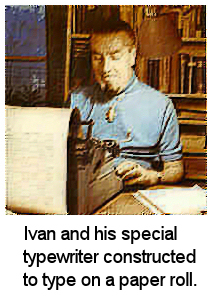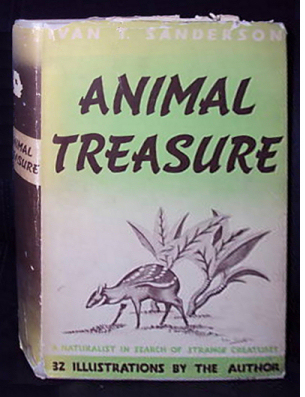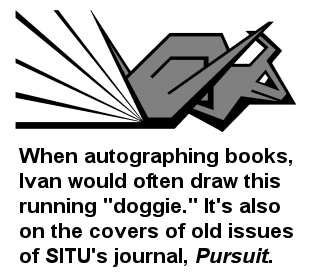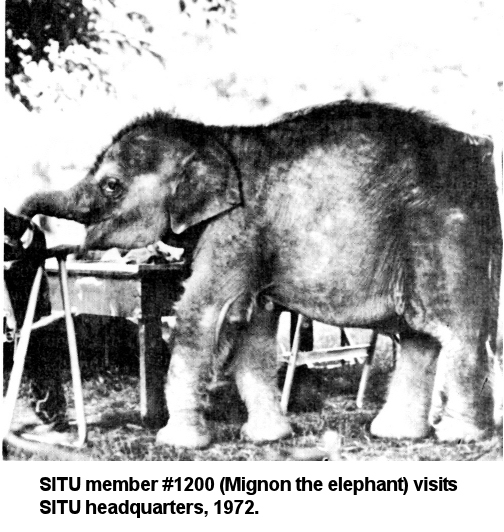Ivan T. Sanderson — Chapter 11 — Kookbooks and Finale
BOOKS:
1937 ANIMAL TREASURE (Viking), a Book-of-the-Month-Club selection.
1938 ANIMALS NOBODY KNOWS (Viking), a juvenile.
1939 CARIBBEAN TREASURE (Viking)
1940 LIVING TREASURE (Viking)
1941 MYSTERY SCHOONER (Viking), Jun. Lit. Guild, (nom-de-pl), fiction.
1946 ANIMAL TALES (Knopf), an anthology.
1950 HOW TO KNOW THE NORTH AMERICAN MAMMALS (Little, Brown; New American Library)
1952 THE SILVER MINK (Little, Brown), fiction.
1953 JOHN AND JUAN IN THE JUNGLE (Dodd, Mead), fiction.
1955 LIVING MAMMALS OF THE WORLD (Hanover House)
1956 THE STATUS QUO (Merlin Press) (nom-de-pl), fiction.
1956 FOLLOW THE WHALE (Little, Brown)
1957 THE MONKEY KINGDOM (Hanover House.)
1961 ABOMINABLE SNOWMEN (Chilton Books)
1961 THE CONTINENT WE LIVE ON (Random House)
1962 THE DYNASTY OF ABU (Knopf)
1965 BOOK OF GREAT JUNGLES (Messner)
1966 THIS TREASURED LAND (Putnam, NY)
1967 UNINVITED VISITORS (Cowles Education Corp.)
1967 "THINGS" (Pyramid Publications, Inc.)
1968 ABOMINABLE SNOWMEN (abridged edition) (Pyramid Publications, Inc.)
1969 MORE "THINGS" (Pyramid)
1970 INVISIBLE RESIDENTS (World Publishing)
1972 INVESTIGATING THE UNEXPLAINED (Prentice-Hall)
1974 GREEN SILENCE (with Sabina Sanderson; David McKay Co.)
 Here's a factor in Ivan Sanderson's prolific accomplishments: He owned a specially-modified manual typewriter (seen at right) that fed a continuous roll of paper into the machine and over the platen. Ivan typed at such a pace that he disliked wasting time whenever he had to feed another individual sheet of paper into a typewriter. Moreover, editing a manuscript in the form of a single long sheet of paper was quite easy—one could see the flow of the book in long stretches of paper, and moving sections around simply required some Scotch tape and a pair of scissors. The printer of SITU's journal Pursuit, Rog Hicks, could put the typed-on paper roll on a section of broomstick handle and unspool the paper as he did typesetting for the journal using what appeared to be a (perpetually misaligned) Justowriter. For book publishers, Ivan would still retype a final draft on conventional 8.5 x 11-inch pages, or cut the roll into individual pages.
Here's a factor in Ivan Sanderson's prolific accomplishments: He owned a specially-modified manual typewriter (seen at right) that fed a continuous roll of paper into the machine and over the platen. Ivan typed at such a pace that he disliked wasting time whenever he had to feed another individual sheet of paper into a typewriter. Moreover, editing a manuscript in the form of a single long sheet of paper was quite easy—one could see the flow of the book in long stretches of paper, and moving sections around simply required some Scotch tape and a pair of scissors. The printer of SITU's journal Pursuit, Rog Hicks, could put the typed-on paper roll on a section of broomstick handle and unspool the paper as he did typesetting for the journal using what appeared to be a (perpetually misaligned) Justowriter. For book publishers, Ivan would still retype a final draft on conventional 8.5 x 11-inch pages, or cut the roll into individual pages.
As friend and SITU member Curtis Sutherly wrote of Ivan in this regard...
Ivan was one of two writers I have known who could produce a lengthy, printable story first draft, no revisions. (John R. Lindermuth, a former newspaper colleague, was the other.) Ivan wrote on an old manual typewriter with a continuous roll of paper fixed over the machine. When the story or book was completed, he would cut the roll into pages and submit them to his publisher. He wrote in the same way he spoke—an easy, often folksy speech that anyone could follow and enjoy. [Sutherly, Curtis. Strange Encounters: UFO's, Aliens & Monsters Among Us. St. Paul, Minnesota: Llewellyn Publications. 1996. p. xvii.]
RG: Well, let’s leave Fort and go on now to what you are doing in the field of writing. You’ve written quite a few books, about 21 I think.
ITS: Tomorrow afternoon I’m going to finish my 26th.
RG: Invisible Residents?
ITS: That’s done. That’s all about the possibility of an underwater civilization, and about a lot of UFOs coming out of the water, and so on. I’ve also written a trilogy: Things, More Things, and this is Still More Things [actually published under the title: Investigating the Unexplained]. This is a hardback book, and they’ve given me about 200 illustrations, which makes life a lot easier. I’m looking forward very much to the day after tomorrow, because then I get on my drawing board, and I love to draw illustrations for my books. I can now do all these nice drawings for this new book; and then what we’re going to do, Richard, is: I own the copyright to Things and More Things which came out in paperback without illustrations. When we get this finished we’re going to do a huge coffeetable or “bedside book” of all three of them together. We’re going to bring all of the sea monsters and things in one place. [Ivan did not live long enough to do this compilation.]
RG: You’ve written about your various travel experiences.
ITS: Yeah, the first three were personal experiences about collecting animals for the museums. That was Animal Treasure, Caribbean Treasure, and Living Treasure. Then came the War, which mucked up everything, and then I had written what they call a “childrens’ book.” It was called Animals Nobody Knows. I told them it wouldn’t sell—the title was stupid. They wanted me to write for nine-year-olds and I said: “I won’t, because they have far more intelligence than a twenty-year-old!” Then I wrote an anthology of my favorite animal tales, called Animal Tales. I love that book, it's still in print.
RG: One of your most famous was The Continent We Live On.
ITS: Yes. I started a whole series for Chanticleer Press. Actually it was done by Random House. You see, I wrote The Continent We Live On, then I was going to write The Continent We Lived On, which is Europe, and then The Continent They Lived On, which is Africa. My health broke down for a time and I couldn’t do it, and I got involved with a lot of other things. It’s become a series though, and they do have one book on each of the continents now: Australia, South America, Africa, and Europe. I wanted them to do Eurasia, because people are so stuck with the idea that Europe is a continent, and it’s not. They’ve done two on Asia. They should have done one on Orientalia, and another one on Eurasia, which is Europe and Russia and Siberia.
RG: Of course, another one of your famous books has to do with the Abominable Snowmen, or “ABSMs” as you like to call them.
ITS: Yes, but wait a minute, you see, in between those two there is another whole series on animals. And I had a book called Living Mammals of the World. Then they went ahead and did Living Birds, Fishes, Reptiles, Amphibians, Insects and Living Animals of the World. That was another whole series, a big one with photographs.
Then I got bored with animals, frankly. I’d lived with them all my life and I wanted to do a book on strange animals, but people didn’t quite see it. I instead started a tremendous work—about 20 volumes. It was a dictionary of animals by their English names—I put the Latin name afterwards. When the average person asks: “What’s a Gophi?” or, “What’s a Dori fish?” they could look it up. But what happened was that these same people would then say: “Well, in Florida this fish is called that, and it looks like this, but in San Francisco they call it by an entirely different name.” That got too involved because then we got into—well, I found out that I had to do it in four languages. That got a little exaggerated, so we canned that. Then I turned over to the things that have always interested me, the Abominable Snowmen, which you just brought up. It was strictly “nothing” when I started the book, and now its 500 pages. It's ten years old, and still in print.
RG: Altogether it’s 525 pages, with the index.
ITS: Ah well, you know what the Spanish say: “#$%_&’()!” [That’s what it sounded like, anyway—RG] Then I started Things and More Things, and then I got into the UFO book, and then another UFO book, and now, today, I finished Still More Things. Now I’m through with all that lot, and I’m going to write, well, I hope I’m going to write a book of my personal experiences. [He almost did. Entitled, Green Silence, it was finished after his death by his second wife, Marion L. Fawcett—"Sabina Warren Sanderson".]
_____________
 Sanderson's first book, Animal Treasure, was a major success and a Book-of-the-Month Club selection. The reviews of it were positively glowing, and many snippets of these adorned the dust jacket:
Sanderson's first book, Animal Treasure, was a major success and a Book-of-the-Month Club selection. The reviews of it were positively glowing, and many snippets of these adorned the dust jacket:
“More exciting than any naturalist’s exploration book I have read. ... An imagination disciplined by orthodox science gives to Animal Treasure its humor, its zest, and its constant intimations of a new way of living that is even more exciting than Africa.”
—Henry Seidel Canby,
Saturday Review of Literature.“His sympathy toward animals is as rich as his eye for observed detail is acute and his prose style is limpid.”
—Time Magazine.“His book is a wonder... Manages somehow to be fascinating on almost every page.”
—Clifton Fadiman,
New Yorker.“I know of no book that brings the African jungles nearer to the armchair.”
—Robert Van Gelder,
New York Times“I felt as though I had been shown Africa through some sort of human microscope... Animal Treasure is indeed a work of art from start to finish.”
—Clifford H. Pope,
New York Herald Tribune Books.Animal Treasure was such a success that it helped finance Ivan’s later expeditions.
In 1961, the scientific community was shocked to discover that their distinguished comrade, Ivan T. Sanderson, the man who had brought them all of those witty, brilliant and engaging books about his expeditions around the world, had now written a huge (150,000-word) magnum opus on strange hominid creatures allegedly inhabiting the world's forests and jungles. It was entitled Abominable Snowmen: Legend Come to Life (Philadelphia: Chilton) and it was up to the distinguished Carleton S. Coon, physical anthropologist, to review this book for Natural History magazine. His tense review ended with:
I view this book with mixed feelings. I wish that Sanderson had been less chatty, colloquial, repetitive, and angry. His excursions into physical anthropology and human paleontology are subprofessional. I can understand his impatience with armchair “experts,” but grow tired of hearing about their delinquencies. Still, the author has made at least one substantial point. The Yeti tracks found in Nepal by several reliable explorers seem to be those of some kind or kinds of large primate. Fundamentally, it is up to the anti-ABSM partisans to prove that nowhere in the world does a zoologically unrecognized pongid or other bipedal primate exist, as well as to find the other animal that makes the cryptic footprints in Nepal.
Let us hope that the orientation of this book, transparently aimed at a wide sale to sensation-seekers, will not discourage serious professional zoologists and anthropologists from making an all out effort to clarify this all too tangled question. Let us also hope—pending the possible delivery of some such animal, alive or dead— that the experts will not be moved to withdraw even farther behind the shelter of their microscopes.” [Coon, Carleton S. (1962) Reviews: Exercises in unnatural history. Natural History, 71(1), 5.]
It should be noted that Coon was known to put forth some controversial hypotheses of his own—particularly in his book, The Origin of Races.
 The tide was beginning to turn against Ivan. Despite this “courteous” review, many scientists look upon Abominable Snowmen: Legend Come to Life, as something as anomalous as the legendary creatures it examines. At some point if must have dawned on him that his bizarre fortean masterwork had tainted his reputation. Scientists, thinking that the whole subject of Bigfoot and other unexplaineds were a lot of hooey, began to get the notion that some of Ivan's other accounts of his journeys were perhaps exaggerations or the work of a complete fabulist. Many scientists now felt that Ivan had finally gone too far in his more fantastic investigations, that he had finally "crossed the line."
The tide was beginning to turn against Ivan. Despite this “courteous” review, many scientists look upon Abominable Snowmen: Legend Come to Life, as something as anomalous as the legendary creatures it examines. At some point if must have dawned on him that his bizarre fortean masterwork had tainted his reputation. Scientists, thinking that the whole subject of Bigfoot and other unexplaineds were a lot of hooey, began to get the notion that some of Ivan's other accounts of his journeys were perhaps exaggerations or the work of a complete fabulist. Many scientists now felt that Ivan had finally gone too far in his more fantastic investigations, that he had finally "crossed the line."
A book which followed, The Continent We Live On, was probably the most beautifully illustrated nature book ever published about the North American continent, and certainly was the finest nature book Ivan had ever written. Color photographs by the dozen (which were still a rarity back in 1962) were incorporated into this huge work that was published by Random House, the material of which had been accumulated through Ivan’s personal 60,000-mile tour of this continent in his station wagon. You might say that the trip (which lasted for about a year) was his final major “expedition.”
Some critics thought thought The Continent We Live On was quite good, but others, having not forgiven Ivan for his previous work, wanted to cast this dangerous derelict out of their intellectual midst.
After all, the man writes all these acceptable books on his travels and on animals; then he writes a “crazy” book on Abominable Snowmen; and now he writes this “sane” book on North America. Goodness, they reasoned, somebody's liable to believe him. Ivan Sanderson had thus fallen into the same trap as Charles Fort: Write about something that most everyone considers “kooky,” and you will be branded as being kooky yourself.
In his review of The Continent We Live On in the March 1962 issue of Natural History magazine, Jack McCormick, an ecologist at Ohio State University, wrote:
As an example of excellence in landscape and wildlife photography, combined with fine printing and craftsmanship, this volume is unsurpassed. Regrettably, the book is badly marred by its accompanying text—the work of Ivan T. Sanderson, who is rapidly rising to the office of high priest of nature fakers. His occasionally lucid but generally mediocre text is a case study in faulty interpretation, undocumented claims, fictitious awe, and totally unnatural history... It is at least a relief to find that the strange, humanoid creatures which, according to Mr. Sanderson’s previous writings, are roaming undiscovered through our western wildernesses, find no mention here.” [McCormick, Jack. (1962) Reviews: Two views of our land. Natural History, 71(3), 4-5.]
Although Ivan claimed that he could substantiate the alleged “errors” of his book, Random House hired Anne Terry White to rewrite and shorten the original text of The Continent We Live On who, in the process of doing so, just happened to eliminate most of the “errors” of the original, much to the consternation of Ivan. This revised version was published as “A special edition for young readers,” and was somewhat cheaper in price than its awesome parent.
Ivan’s last non-fortean-oriented books were This Treasured Land, a picture book that canvassed the people and cities of North America, thus picking up were The Continent We Live On left off; The Dynasty of Abu, a book about elephants; and Ivan Sanderson’s Book of Great Jungles, in which he looked at the history of jungle exploration and summarized some of his jungle experiences that had not appeared in his old, best-selling “travel trilogy,”Animal Treasure, Caribbean Treasure, and Living Treasure.
It appeared that the Scientific Establishment had given “The Wipe”—and a colossal one at that— to Ivan and his reputation. Although Ivan Sanderson published many articles in the newspapers and popular magazines, his scientific papers now found only one outlet, an Italian Journal called Genus.
RG: One more question: What is a man of your prominence doing out here in the New Jersey woods?
ITS: That’s an interesting question. I’ll tell you why. I think our cities stink. I think most of our civilization stinks. I’ve been, more or less, all over the world, and I find that all people are nice, on the whole. I mean really they are. But I think that Warren County, New Jersey is as beautiful as I’ve seen in North America. I had a heck of a lot of animals, they were all killed in a fire, but I had a nice place to put them. I love to carpenter and build and cut grass, and so on. You know, it’s good for you. The water is perfect here, and the air is clean, the people are decent, there’s no noise, I don’t see anything in the way of civilization, and I can get some work done. I still have my place in New York, an apartment. I go down there once a week to do a radio show.
I looked around when I sort of retired from television, which was in 1958 when I went around the continent to write that book, The Continent We Live On, and I saw how beautiful this country really is. I would never live in a modern, congested city. After all, I had originally bought this place, saying: “When I ‘come back’ for the last time and settle down, I’m not going to sweat it out in New York.” We call that "Stink City" now. It’s filthy. When I first went there it was beautiful and lovely. Now it’s a mess. I mean the people are as bad as the paper in the streets, and they don’t mend the streets, and the prices, and the food is lousy, and “blahhhh.” No, give me Warren County. Warren and Sussex are all right—as long as we keep the bums out.
That’s why I came here, simply because I wanted a little peace and quiet in my old age.
RG: So we’ll be looking for your new books coming out soon.
ITS: You’ll get them, I’ll send you a copy. I don’t know if you realize this, but you’re an honorary member of our Society now, and that you shall receive our journal free—I’ll sneak it to you somehow.
RG: I don’t have to pay the 10 dollars in membership dues either! Membership in the National Geographic Society is only $7.50, you know.
ITS: You see, with the National Geographic Society you only get a magazine, but with us you have membership, visiting privileges, and you get our magazine which is five dollars to the four issues. All right?
RG: Sure. If one wishes to become a member of your organization, how should he go about it?
ITS: I would say, one—get in touch with you; two—simply write to me, Sanderson, Columbia, New Jersey. That’s all you need, everybody knows me around here. If you’re interested and want to know what its all about, then we’ll send you what we call a brochure, which is one piece of paper folded once. It’s got a little subscription blank attached to the back that you can tear off. It tells you who we are, what we do, and gives a list of all the scientists who back us. This is especially good for young people, who can show it to their parents and say: “Look here, this is not some kooky organization.” They can then look up the names, and see who’s who, and see that it’s all right. I’d say to any of your listeners to get in touch with you, if they’re really interested. And do impress upon them that you don’t have to be a scientist. You don’t even have to be particularly interested in science. Your age doesn’t mean a darn thing, nor does your color, nor does your religion—we’ve even got some striped and polka-dotted members!
RG: Really!
 Ivan was telling the truth—his understated British humor was priceless: I later discovered that SITU's "Honorary Member No. 1200" was a baby elephant named Mignon who lived as a housepet in Gillete, New Jersey. Mignon slept each night in the owners' garage, on a pile of plywood sheets covered with layers of blankets. Mignon's owners brought her to visit SITU headquarters one day in 1972 (see photo at right), where she took a dip in one of the ponds. "...though she was somewhat annoyed when forbidden to wrech our trash burner, composed of unmortered cinder blocks, by leaning on it; and frustrated to the point of screaming when refused entry for the fourth time to Bus No. 1 which houses the potting shed and our small lab. Like all true forteans she possess unbounded curiosity," as Sabina wrote in the October 1972 issue of Pursuit. Ivan said that Mignon was the the most charming, best-behaved baby elephant he had ever encountered. (Unlike Mignon, young elephants tend to be rambunctious creatures.) Mignon eventually outgrew her garage accommodations and was forced to join a circus.
Ivan was telling the truth—his understated British humor was priceless: I later discovered that SITU's "Honorary Member No. 1200" was a baby elephant named Mignon who lived as a housepet in Gillete, New Jersey. Mignon slept each night in the owners' garage, on a pile of plywood sheets covered with layers of blankets. Mignon's owners brought her to visit SITU headquarters one day in 1972 (see photo at right), where she took a dip in one of the ponds. "...though she was somewhat annoyed when forbidden to wrech our trash burner, composed of unmortered cinder blocks, by leaning on it; and frustrated to the point of screaming when refused entry for the fourth time to Bus No. 1 which houses the potting shed and our small lab. Like all true forteans she possess unbounded curiosity," as Sabina wrote in the October 1972 issue of Pursuit. Ivan said that Mignon was the the most charming, best-behaved baby elephant he had ever encountered. (Unlike Mignon, young elephants tend to be rambunctious creatures.) Mignon eventually outgrew her garage accommodations and was forced to join a circus.
ITS: I’d like to ask you a question. You play this to your assembly things or groups?
RG: Well, perhaps. I’m making this tape more for reasons of posterity than anything else. I believe that the members of the Creative Writing Class at the High School in Newton have been trying to get you back for a talk.
ITS: Yes, I know. I did come up once and they very kindly invited me again, but I’m in the news business as well. You see, sea monsters will not send me telegrams telling me where they are going to land!
RG: You’re also the Science Editor at Argosy Magazine.
ITS: Yeah. Well, I’m more than that, I’m with North American Newspaper Alliance as well, that’s a news service. That’s “spot news” as we call it, or “topical stuff.” If something happens, they say: “Get in an airplane, Sanderson, and get out there!”
That’s why I’ve given up lecturing and talking and the platform because my newswork takes precedence, and maybe the night before a lecture I have to ring up and say: “I’m sorry, I’m not going to be with you.” What’s the poor program chairman going to do? He’s stuck with nobody. So I’ve said: “No, I’ll cut it out.” I think its better, its fairer to everybody. If, on the other hand, you want to get somebody else who doesn’t mind standing in, just in case something happens, then I’ll come over if I can—but I can’t do it, Richard. [Ivan's honorarium for public speaking in the 1960s was $500 a lecture—a little over $3,000 in 2009 U.S. dollars.]
RG: There is one quote that seems to have been associated with you over the years. That is, “Science is the Pursuit of the Unknown,” can you explain why?
ITS: That’s our gimmick, which is on the front of our magazine.
RG: I was wondering what great literary figure they quoted that from.
ITS: You know where that’s quoted from?
RG: Where?
ITS: The Oxford Standard Dictionary. If you look up the word “science” in the Oxford Dictionary—as a matter of fact, it's in Webster’s too, but it starts off by saying: “Science is the pursuit of the unknown.” Not the known. That’s technology.
RG: Well, thank you, Mr. Sanderson—Ivan—for a very enlightening conversation, and I’m sure that anyone listening to this will be swayed to your side and lines of reasoning.
ITS: It’s been great fun, Richard, really.
RG: Except, I’m sure, for the 20-to-40-year-olds.
ITS: Well, if you play this for a high school group with middle-aged chaps, have them stand in the back. When I give lectures at colleges I usually ask the faculty to come in, and I notice a thundering silence from them when I ask for questions.
RG: Thank you, Ivan Sanderson.
Home — Next: Chapter 12: And now young man, you are going to be on my radio show. — Top of Page

